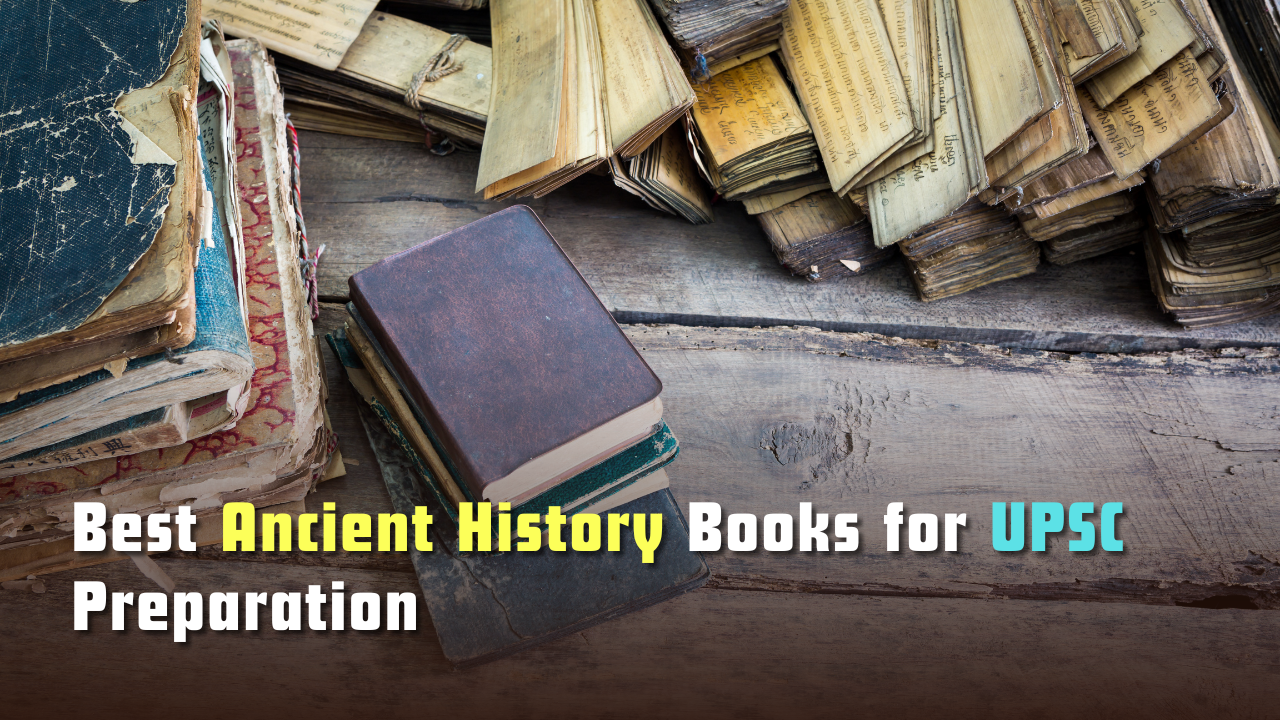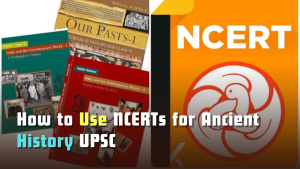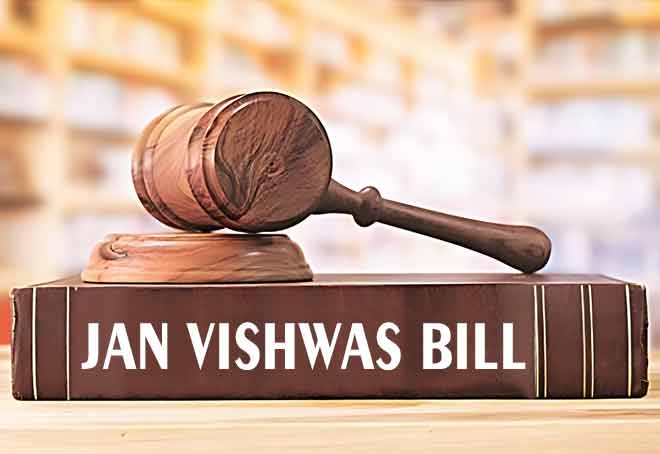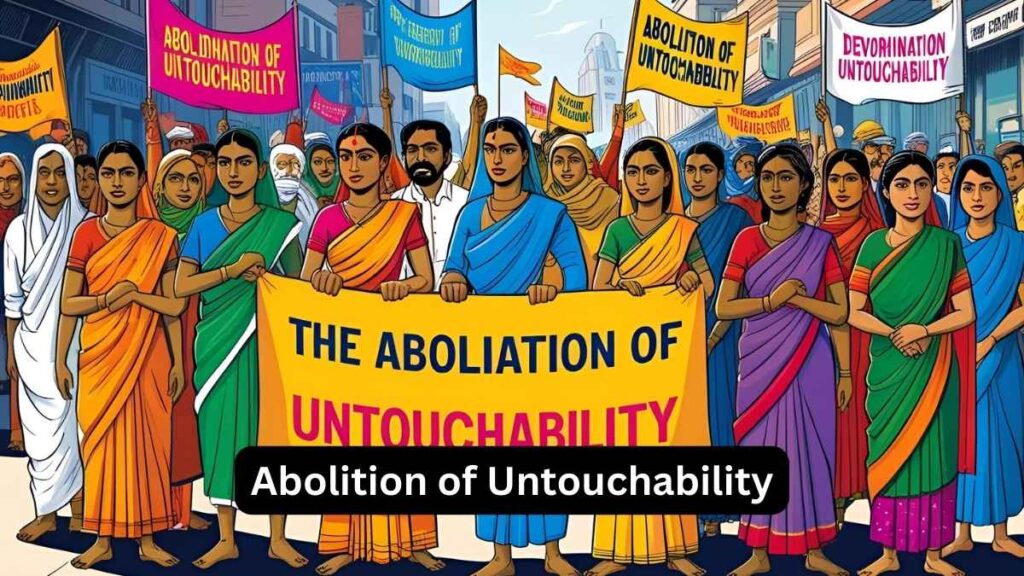Best Ancient History Books for UPSC Preparation
Context: Discover the top ancient history book for UPSC and understand how to study them effectively. Compare recommended history books for UPSC and boost your preparation.
Why Ancient History is Crucial for UPSC
Ancient history plays a central role in Paper I of the General Studies Mains and forms a major chunk of History questions in Prelims. The syllabus covers prehistoric cultures, Harappan civilization, Vedic Age, religious movements like Buddhism and Jainism, Mauryan and Gupta empires, and cultural developments. UPSC’s focus has shifted towards analytical and cultural themes over rote facts. Hence, understanding ancient history helps not just in History, but also in Culture, Ethics (value systems), and Essay papers. Moreover, history questions are often high-scoring if backed by conceptual clarity.
How to Read Ancient History Effectively
Reading should be thematic, not just chronological. Begin by mapping the syllabus with book chapters. While reading, maintain concise notes under fixed heads—political, economic, religious, and cultural. Make mind maps to link developments across periods. For instance, link Vedic religion to Upanishadic thought and later Bhakti movements.
Solve Ancient History PYQs UPSC Mains to understand question trends. UPSC often repeats themes like Ashokan Dhamma, Gupta art, or Sangam polity. Focus on understanding the causes and consequences of historical transitions rather than just events. Supplement your reading with NCERT illustrations, coins, inscriptions, and art references to enrich your Mains answers.
Recommended Books by Toppers
The top recommended ancient history book for UPSC is India’s Ancient Past by RS Sharma, published by Oxford University Press. It is widely endorsed by toppers for its analytical clarity, balanced coverage of socio-political and cultural themes, and easy-to-understand narrative. The author explains complex developments such as caste evolution, agrarian expansion, and trade networks with clarity, which aligns well with Mains demands.
Another frequently recommended book is the Tamil Nadu Class 11 History textbook, known for its concise format and clear chronological layout. It is highly useful for Prelims due to its fact-rich content and diagrammatic explanations. It simplifies major events and makes retention easier for beginners.
Some also use the Old NCERT Ancient India by RS Sharma, which although outdated in parts, is still valuable for foundational knowledge. Additionally, NIOS modules on Indian Culture and Heritage provide simple summaries and pictorial content that aid visual memory.
Book Comparison: RS Sharma vs. Tamil Nadu Board or Other Examples
A comparative look helps in choosing wisely. RS Sharma’s book offers comprehensive analysis, which is ideal for both Prelims and Mains. It explores societal changes, economic systems, and philosophical growth across ages. On the other hand, the Tamil Nadu textbook is crisp, direct, and factual, catering well to beginners and quick revision needs.
Those seeking a hybrid approach often start with Tamil Nadu’s book and then graduate to RS Sharma. This helps build a base and then dive deeper into critical analysis. NIOS modules can serve as support for art, architecture, and religion-based topics, commonly asked in both GS and optional papers.
Book-by-Book Content Analysis for Ancient History UPSC
To choose the best ancient history book for UPSC, aspirants must know not just which books to read, but also what each book offers in terms of topics, depth, and utility. Here’s a detailed breakdown:
1. India’s Ancient Past – RS Sharma (Old NCERT)
Author: R.S. Sharma
Publisher: Oxford University Press
Why It Stands Out: Most recommended for UPSC Prelims and Mains due to clarity and analytical depth.
Topics Covered:
- Prehistoric cultures (Paleolithic, Mesolithic, Neolithic)
- Indus Valley Civilization (urban planning, trade, decline)
- Vedic Age (Early and Later Vedic society)
- Mahajanapadas and Rise of Magadha
- Religious movements: Jainism and Buddhism (doctrines, councils)
- Mauryan Empire (Ashokan edicts, administration)
- Post-Mauryan India (Indo-Greeks, Shakas, Kushanas)
- Gupta and Post-Gupta Periods (science, art, administration)
Utility:
- Excellent for both Prelims factual recall and Mains analytical writing.
- Each chapter aligns with major themes of UPSC syllabus like polity, society, religion, economy.
Pro Tip: Use its chapter-end summaries and timeline features for quick revision.
2. Tamil Nadu Class 11 History Textbook (New Syllabus)
Board: Tamil Nadu State Board
Why It Stands Out: Concise, factual, to-the-point. Perfect for factual questions in UPSC Prelims.
Topics Covered:
- Human Evolution and Prehistoric Cultures
- Harappan and Vedic Civilizations
- Second Urbanization and 16 Mahajanapadas
- Mauryan Administration and Asoka’s Dhamma
- Sangam Age, South Indian Kingdoms (Cholas, Cheras, Pandyas)
- Bhakti & Jain/Buddhist Movements
- Temple Architecture, Literature, Science and Tech in Ancient India
Utility:
- Quick reading and revision tool
- Includes many South Indian developments often skipped in NCERTs
- Especially useful for Art & Culture overlap
Pro Tip: Match each topic with PYQs (Previous Year Questions) to solidify retention.
3. Themes in Indian History – Part I (Class 11 NCERT)
Author: NCERT
Why It Stands Out: Strong conceptual coverage, good narrative flow, UPSC-aligned themes.
Topics Covered:
- Early Societies (archaeological findings, hunter-gatherers)
- Harappan Civilization (settlements, trade, seals, craft production)
- Vedas and Later Vedic period (rituals, social order)
- Buddhism & Jainism with textual sources
- Mauryan State and Economy
- Gupta Period and urban decline
Utility:
- Must-read for UPSC Mains – introduces how history is written (sources & interpretations)
- Excellent for source-based analysis questions
- Builds a strong foundation of chronology and socio-political structures
Pro Tip: Focus on reading boxes, inscriptions, and visuals included in the book.
4. A History of Ancient and Early Medieval India – Upinder Singh
Author: Upinder Singh (Historian, DU professor)
Why It Stands Out: Scholarly, in-depth, academic resource with a wide canvas
Topics Covered:
- Stone Age to 1300 CE in a single narrative
- Rigorous use of primary sources (inscriptions, coins, texts)
- Regional histories and early state formations
- Detailed chapters on Mauryas, Guptas, Vakatakas, Pallavas, Chalukyas, Rashtrakutas
- Religion, art, architecture, and literary works in socio-political context
Utility:
- Best for Optional History Paper I (esp. Mains)
- Rich material for building analytical and critical answers
- Great for map-based questions and essay-type narratives
Pro Tip: Not ideal for beginners due to academic depth—use after NCERTs and RS Sharma.
5. History of Ancient India – Romila Thapar (for Optional)
Author: Romila Thapar
Why It Stands Out: Critical historical analysis and interpretation of socio-political patterns
Topics Covered:
- Early Social Formations, State and Economy
- Political transition and legitimacy
- Ideas of kingship and dharma
- Gender, culture, and stratification in Ancient India
Utility:
- Advanced-level reference for History Optional students
- Helps in understanding historical interpretations and debates
- Strong theoretical base for writing value-added answers in Mains
Pro Tip: Pair with Upinder Singh’s book for Paper I of Optional.
Book Comparison Table: At a Glance
| Book Name | Best For | Covers | Style | Difficulty |
| India’s Ancient Past – RS Sharma | Prelims + Mains | Entire Syllabus | Balanced | Easy–Medium |
| Tamil Nadu Class 11 History | Quick Prelims prep | Facts + South India | Factual | Easy |
| Themes in Indian History – NCERT | Mains + Essay | Conceptual Themes | Analytical | Medium |
| Upinder Singh – Ancient India | Optional Paper I | Full with Sources | Academic | Medium-Hard |
| Romila Thapar – Ancient India | Advanced Mains | Critical Thinking | Scholarly | Hard |
Subscribe to our Youtube Channel for more Valuable Content – TheStudyias
Download the App to Subscribe to our Courses – Thestudyias
The Source’s Authority and Ownership of the Article is Claimed By THE STUDY IAS BY MANIKANT




